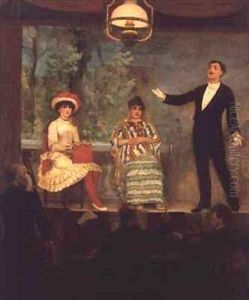C.A. Paul de la Boulaye Paintings
C.A. Paul de la Boulaye, whose full name is Charles-Amable Paul de la Boulaye, was a French painter born on May 14, 1849, in Digoin, Saône-et-Loire. He was known for his genre scenes, landscapes, and portraits, often imbued with a sense of realism and attention to detail, which were characteristic of the period's academic art.
De la Boulaye studied at the École des Beaux-Arts in Paris under the tutelage of renowned artists such as Isidore Pils and Henri Lehmann. These teachers were influential in the 19th-century French art scene and provided de la Boulaye with a solid foundation in the techniques of painting that adhered to the strict academic standards of the time.
Throughout his career, de la Boulaye exhibited his works at the Paris Salon, the official art exhibition of the Académie des Beaux-Arts in Paris. He made his debut at the Salon in 1873 and continued to participate in this prestigious event for many years. His paintings often depicted everyday life and the rural landscapes of France, capturing the essence of the French countryside with a romanticized flair that was popular among art patrons of the era.
De la Boulaye's works were well-received, and he gained recognition and accolades for his artistic contributions. His style reflected the influence of the academic art movement, yet he managed to infuse his works with a personal touch that resonated with the viewers. In the late 19th and early 20th centuries, the art world began to shift towards modernism, and while de la Boulaye's work did not align with the avant-garde movements of his time, he maintained a respected position within the sphere of traditional academic painting.
C.A. Paul de la Boulaye's legacy is that of a skilled painter who captured the spirit of his time through meticulous craftsmanship and a dedication to the aesthetics of academic art. His paintings continue to be appreciated by collectors and art enthusiasts who value the beauty and realism of the 19th-century French art tradition.
Charles-Amable Paul de la Boulaye passed away on September 20, 1926, leaving behind a body of work that continues to be studied and admired for its historical and artistic significance within the context of French art history.
